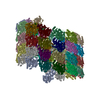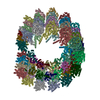[English] 日本語
 Yorodumi
Yorodumi- EMDB-26020: The tubulin-based conoid from detergent-extract Toxoplasma gondii... -
+ Open data
Open data
- Basic information
Basic information
| Entry |  | ||||||||||||||||||
|---|---|---|---|---|---|---|---|---|---|---|---|---|---|---|---|---|---|---|---|
| Title | The tubulin-based conoid from detergent-extract Toxoplasma gondii cells | ||||||||||||||||||
 Map data Map data | |||||||||||||||||||
 Sample Sample |
| ||||||||||||||||||
 Keywords Keywords | parasites / Toxoplasma gondii / cytoskeleton / conoid / tubulin / CELL INVASION | ||||||||||||||||||
| Function / homology |  Function and homology information Function and homology informationmicrotubule-based process / structural constituent of cytoskeleton / Hydrolases; Acting on acid anhydrides; Acting on GTP to facilitate cellular and subcellular movement / microtubule / hydrolase activity / GTPase activity / GTP binding / metal ion binding / cytoplasm Similarity search - Function | ||||||||||||||||||
| Biological species |  | ||||||||||||||||||
| Method | subtomogram averaging / cryo EM / Resolution: 9.3 Å | ||||||||||||||||||
 Authors Authors | Sun SY / Pintilie GD / Chen M / Chiu W | ||||||||||||||||||
| Funding support |  United States, 5 items United States, 5 items
| ||||||||||||||||||
 Citation Citation |  Journal: Proc Natl Acad Sci U S A / Year: 2022 Journal: Proc Natl Acad Sci U S A / Year: 2022Title: Cryo-ET of parasites gives subnanometer insight into tubulin-based structures. Authors: Stella Y Sun / Li-Av Segev-Zarko / Muyuan Chen / Grigore D Pintilie / Michael F Schmid / Steven J Ludtke / John C Boothroyd / Wah Chiu /  Abstract: Tubulin is a conserved protein that polymerizes into different forms of filamentous structures in , an obligate intracellular parasite in the phylum Apicomplexa. Two key tubulin-containing ...Tubulin is a conserved protein that polymerizes into different forms of filamentous structures in , an obligate intracellular parasite in the phylum Apicomplexa. Two key tubulin-containing cytoskeletal components are subpellicular microtubules (SPMTs) and conoid fibrils (CFs). The SPMTs help maintain shape and gliding motility, while the CFs are implicated in invasion. Here, we use cryogenic electron tomography to determine the molecular structures of the SPMTs and CFs in vitrified intact and detergent-extracted parasites. Subvolume densities from detergent-extracted parasites yielded averaged density maps at subnanometer resolutions, and these were related back to their architecture in situ. An intralumenal spiral lines the interior of the 13-protofilament SPMTs, revealing a preferred orientation of these microtubules relative to the parasite's long axis. Each CF is composed of nine tubulin protofilaments that display a comma-shaped cross-section, plus additional associated components. Conoid protrusion, a crucial step in invasion, is associated with an altered pitch of each CF. The use of basic building blocks of protofilaments and different accessory proteins in one organism illustrates the versatility of tubulin to form two distinct types of assemblies, SPMTs and CFs. | ||||||||||||||||||
| History |
|
- Structure visualization
Structure visualization
| Supplemental images |
|---|
- Downloads & links
Downloads & links
-EMDB archive
| Map data |  emd_26020.map.gz emd_26020.map.gz | 2 MB |  EMDB map data format EMDB map data format | |
|---|---|---|---|---|
| Header (meta data) |  emd-26020-v30.xml emd-26020-v30.xml emd-26020.xml emd-26020.xml | 14.8 KB 14.8 KB | Display Display |  EMDB header EMDB header |
| Images |  emd_26020.png emd_26020.png | 101 KB | ||
| Filedesc metadata |  emd-26020.cif.gz emd-26020.cif.gz | 6.2 KB | ||
| Archive directory |  http://ftp.pdbj.org/pub/emdb/structures/EMD-26020 http://ftp.pdbj.org/pub/emdb/structures/EMD-26020 ftp://ftp.pdbj.org/pub/emdb/structures/EMD-26020 ftp://ftp.pdbj.org/pub/emdb/structures/EMD-26020 | HTTPS FTP |
-Validation report
| Summary document |  emd_26020_validation.pdf.gz emd_26020_validation.pdf.gz | 456.7 KB | Display |  EMDB validaton report EMDB validaton report |
|---|---|---|---|---|
| Full document |  emd_26020_full_validation.pdf.gz emd_26020_full_validation.pdf.gz | 456.3 KB | Display | |
| Data in XML |  emd_26020_validation.xml.gz emd_26020_validation.xml.gz | 5.5 KB | Display | |
| Data in CIF |  emd_26020_validation.cif.gz emd_26020_validation.cif.gz | 6.3 KB | Display | |
| Arichive directory |  https://ftp.pdbj.org/pub/emdb/validation_reports/EMD-26020 https://ftp.pdbj.org/pub/emdb/validation_reports/EMD-26020 ftp://ftp.pdbj.org/pub/emdb/validation_reports/EMD-26020 ftp://ftp.pdbj.org/pub/emdb/validation_reports/EMD-26020 | HTTPS FTP |
-Related structure data
| Related structure data |  7tntMC  7tnqC  7tnsC C: citing same article ( M: atomic model generated by this map |
|---|---|
| Similar structure data | Similarity search - Function & homology  F&H Search F&H Search |
- Links
Links
| EMDB pages |  EMDB (EBI/PDBe) / EMDB (EBI/PDBe) /  EMDataResource EMDataResource |
|---|---|
| Related items in Molecule of the Month |
- Map
Map
| File |  Download / File: emd_26020.map.gz / Format: CCP4 / Size: 8 MB / Type: IMAGE STORED AS FLOATING POINT NUMBER (4 BYTES) Download / File: emd_26020.map.gz / Format: CCP4 / Size: 8 MB / Type: IMAGE STORED AS FLOATING POINT NUMBER (4 BYTES) | ||||||||||||||||||||||||||||||||||||
|---|---|---|---|---|---|---|---|---|---|---|---|---|---|---|---|---|---|---|---|---|---|---|---|---|---|---|---|---|---|---|---|---|---|---|---|---|---|
| Projections & slices | Image control
Images are generated by Spider. | ||||||||||||||||||||||||||||||||||||
| Voxel size | X=Y=Z: 3.534 Å | ||||||||||||||||||||||||||||||||||||
| Density |
| ||||||||||||||||||||||||||||||||||||
| Symmetry | Space group: 1 | ||||||||||||||||||||||||||||||||||||
| Details | EMDB XML:
|
-Supplemental data
- Sample components
Sample components
-Entire : a conoid complex of tubulin with other protein components
| Entire | Name: a conoid complex of tubulin with other protein components |
|---|---|
| Components |
|
-Supramolecule #1: a conoid complex of tubulin with other protein components
| Supramolecule | Name: a conoid complex of tubulin with other protein components type: organelle_or_cellular_component / ID: 1 / Parent: 0 / Macromolecule list: all |
|---|---|
| Source (natural) | Organism:  |
-Macromolecule #1: Tubulin alpha chain
| Macromolecule | Name: Tubulin alpha chain / type: protein_or_peptide / ID: 1 / Number of copies: 18 / Enantiomer: LEVO |
|---|---|
| Source (natural) | Organism:  |
| Molecular weight | Theoretical: 48.421031 KDa |
| Sequence | String: MREVISIHVG QAGIQIGNAC WELFCLEHGI QPDGQMPSDK TIGGGDDAFN TFFSETGAGK HVPRCVFLDL EPTVVDEVRT GTYRHLFHP EQLISGKEDA ANNFARGHYT IGKEIVDLSL DRIRKLADNC TGLQGFLMFN AVGGGTGSGL GCLLLERLSV D YGKKSKLN ...String: MREVISIHVG QAGIQIGNAC WELFCLEHGI QPDGQMPSDK TIGGGDDAFN TFFSETGAGK HVPRCVFLDL EPTVVDEVRT GTYRHLFHP EQLISGKEDA ANNFARGHYT IGKEIVDLSL DRIRKLADNC TGLQGFLMFN AVGGGTGSGL GCLLLERLSV D YGKKSKLN FCSWPSPQVS TAVVEPYNSV LSTHSLLEHT DVAVMLDNEA IYDICRRNLD IERPTYTNLN RLIAQVISSL TA SLRFDGA LNVDVTEFQT NLVPYPRIHF MLSSYAPIIS AEKAYHEQLS VAEITNSAFE PASMMAKCDP RHGKYMACCL MYR GDVVPK DVNAAVATIK TKRTIQFVDW CPTGFKCGIN YQPPTVVPGG DLAKVMRAVC MISNSTAIAE VFSRMDHKFD LMYA KRAFV HWYVGEGMEE GEFSEAREDL AALEKDYEEV GI UniProtKB: Tubulin alpha chain |
-Macromolecule #2: Tubulin beta chain
| Macromolecule | Name: Tubulin beta chain / type: protein_or_peptide / ID: 2 / Number of copies: 18 / Enantiomer: LEVO |
|---|---|
| Source (natural) | Organism:  |
| Molecular weight | Theoretical: 47.70582 KDa |
| Sequence | String: MREIVHVQGG QCGNQIGAKF WEVISDEHGI DPTGTYCGDS DLQLERINVF YNEATGGRFV PRAILMDLEP GTMDSVRAGP FGQLFRPDN FVFGQTGAGN NWAKGHYTEG AELIDSVLDV VRKEAEGCDC LQGFQITHSL GGGTGSGMGT LLISKVREEY P DRIMETFS ...String: MREIVHVQGG QCGNQIGAKF WEVISDEHGI DPTGTYCGDS DLQLERINVF YNEATGGRFV PRAILMDLEP GTMDSVRAGP FGQLFRPDN FVFGQTGAGN NWAKGHYTEG AELIDSVLDV VRKEAEGCDC LQGFQITHSL GGGTGSGMGT LLISKVREEY P DRIMETFS VFPSPKVSDT VVEPYNATLS VHQLVENADE VQVIDNEALY DICFRTLKLT TPTYGDLNHL VSAAMSGVTC CL RFPGQLN SDLRKLAVNL IPFPRLHFFL IGFAPLTSRG SQQYRALSVP ELTQQMFDAK NMMCASDPRH GRYLTASAMF RGR MSTKEV DEQMLNVQNK NSSYFVEWIP NNMKSSVCDI PPKGLKMSVT FVGNSTAIQE MFKRVSDQFT AMFRRKAFLH WYTG EGMDE MEFTEAESNM NDLVSEYQQY Q UniProtKB: Tubulin beta chain |
-Experimental details
-Structure determination
| Method | cryo EM |
|---|---|
 Processing Processing | subtomogram averaging |
| Aggregation state | filament |
- Sample preparation
Sample preparation
| Buffer | pH: 7.2 / Details: Phosphate Buffered Saline |
|---|---|
| Grid | Model: Homemade / Material: COPPER / Mesh: 200 / Support film - Material: CARBON / Support film - topology: LACEY / Pretreatment - Type: PLASMA CLEANING / Pretreatment - Time: 25 sec. |
| Vitrification | Cryogen name: ETHANE / Chamber humidity: 90 % / Chamber temperature: 295 K / Instrument: LEICA EM GP |
- Electron microscopy
Electron microscopy
| Microscope | FEI TITAN KRIOS |
|---|---|
| Specialist optics | Energy filter - Name: GIF Bioquantum / Energy filter - Slit width: 20 eV |
| Image recording | Film or detector model: GATAN K2 SUMMIT (4k x 4k) / Detector mode: COUNTING / Average exposure time: 1.2 sec. / Average electron dose: 3.0 e/Å2 |
| Electron beam | Acceleration voltage: 300 kV / Electron source:  FIELD EMISSION GUN FIELD EMISSION GUN |
| Electron optics | C2 aperture diameter: 70.0 µm / Illumination mode: FLOOD BEAM / Imaging mode: BRIGHT FIELD / Nominal defocus max: 5.0 µm / Nominal defocus min: 1.0 µm / Nominal magnification: 81000 |
| Sample stage | Specimen holder model: FEI TITAN KRIOS AUTOGRID HOLDER / Cooling holder cryogen: NITROGEN |
| Experimental equipment |  Model: Titan Krios / Image courtesy: FEI Company |
- Image processing
Image processing
| Final reconstruction | Applied symmetry - Point group: C1 (asymmetric) / Algorithm: FOURIER SPACE / Resolution.type: BY AUTHOR / Resolution: 9.3 Å / Resolution method: FSC 0.143 CUT-OFF / Software - Name: EMAN2 / Number subtomograms used: 29524 |
|---|---|
| Extraction | Number tomograms: 126 / Number images used: 29524 |
| Final angle assignment | Type: OTHER |
 Movie
Movie Controller
Controller













 Z (Sec.)
Z (Sec.) Y (Row.)
Y (Row.) X (Col.)
X (Col.)





















